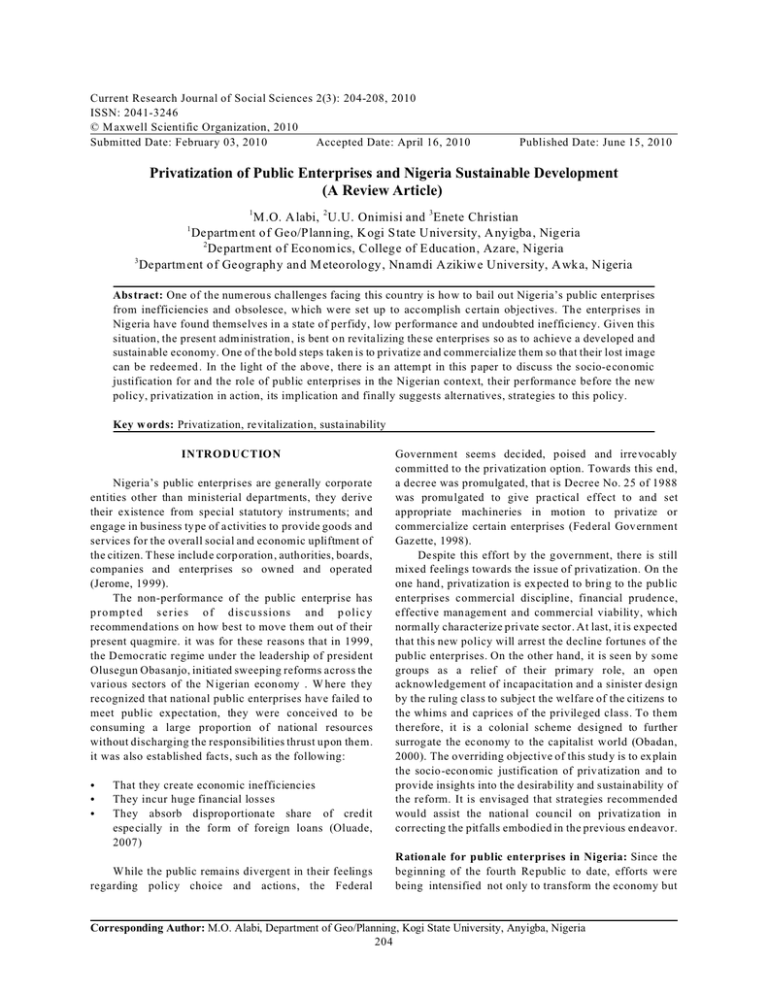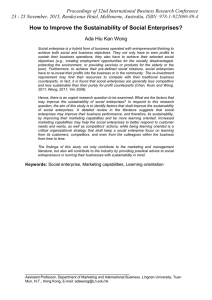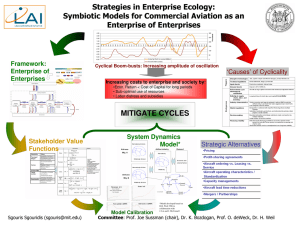Current Research Journal of Social Sciences 2(3): 204-208, 2010 ISSN: 2041-3246
advertisement

Current Research Journal of Social Sciences 2(3): 204-208, 2010 ISSN: 2041-3246 © M axwell Scientific Organization, 2010 Submitted Date: February 03, 2010 Accepted Date: April 16, 2010 Published Date: June 15, 2010 Privatization of Public Enterprises and Nigeria Sustainable Development (A Review Article) 1 M.O. A labi, 2 U.U. Onimisi and 3 Enete Christian 1 Departm ent of Geo/Planning, K ogi S tate University, A nyigba, Nigeria 2 Departm ent of Eco nom ics, College of Education, Azare, Nigeria 3 Departm ent of Geography and M eteorology, Nnamdi Azikiw e University, A wka, Nigeria Abstract: One of the num erous challenges facing this cou ntry is ho w to bail out Nige ria’s public enterprises from inefficiencies and obsolesce, w hich were set up to accomplish certain objectives. Th e enterprises in Nigeria have found themselves in a state of perfidy, low performance and undoubted inefficiency. Given this situation, the present adm inistration, is bent on revitalizing the se enterprises so as to achieve a developed and sustain able economy. One of the bold steps taken is to privatize and commercialize them so that their lost image can be redee med . In the light of the above, there is an attem pt in this paper to discuss the socio-e conomic justification for and the role of public enterprises in the Nigerian context, their performance before the new policy, privatization in action, its implication and finally suggests alternatives, strategies to this policy. Key w ords: Privatization, revitalization, sustainability INTRODUCTION Nigeria’s public enterprises are generally corpo rate entities other than ministerial departments, they derive their existence from special statutory instruments; and engage in business type of activities to provide goods and services for the overall social and economic upliftment of the citizen. T hese include corp oration , authorities, boards, companies and enterprises so owned and operated (Jerome, 19 99). The non-performance of the public enterprise has p r o m p t e d s e r ie s o f d is c u ssions and p olic y recommend ations on how best to move them out of their present quagmire. it was for these reasons that in 1999, the Democratic regime under the leadership of president Olusegun Obasanjo, initiated sweeping reforms across the various sectors of the N igerian economy . W here they recognized that national public enterprises have failed to meet public expectation, they were conceived to be consuming a large proportion of national resources without discharging the responsibilities thrust upon them. it was also established facts, such as the following: C C C That they create economic inefficiencies They incur huge financial losses They absorb d isprop ortiona te share of credit especially in the form of foreign loans (Oluade, 2007) W hile the public remains divergent in their feelings regarding policy choice and actions, the Federal Government seem s decided, poised and irrevocably committed to the privatization option. Towards this end, a decree was promulgated, that is Decree No. 25 of 1988 was promulgated to give practical effect to and set appropriate machineries in motion to privatize or commercialize certain enterprises (Fed eral Gov ernment Gazette, 1998). Despite this effort by the government, there is still mixed feelings towards the issue of privatization. On the one hand , privatiza tion is expected to bring to the public enterprises commercial discipline, financial prudence, effective man agem ent and commercial viability, which norm ally characterize private sector. At last, it is expected that this new policy will arrest the decline fortunes of the public enterprises. On the other hand, it is seen by some groups as a relief of their primary role, an open acknowledgement of incapacitation and a sinister design by the ruling class to subject the welfare of the citizens to the whims and caprices of the privileged class. To them therefore, it is a colonial scheme designed to further surrog ate the economy to the capitalist world (Obadan, 2000). The overriding objective of this study is to ex plain the socio-econ omic justification of priv atization and to provide insights into the d esirability and sustainability of the reform. It is envisaged that strategies recommended would assist the national council on privatiza tion in correcting the pitfalls embodied in the previous en deavor. Rationale for public enterprises in Nigeria: Since the beginning of the fourth Re public to date, efforts w ere being intensified not only to transform the economy but Corresponding Author: M.O. Alabi, Department of Geo/Planning, Kogi State University, Anyigba, Nigeria 204 Curr. Res. J. Soc. Sci., 2(3): 204-208, 2010 also to sustain the temp o of such development efforts. Public Enterprises were not left out in this direction so that they can attain their objectives. Among such justifications as in Central Bank Nigeria Bulletin includes: C C C C C C C The actual perform ance of the public enterprises in Nigeria leaves much to be desired. It is clear that many of them are not responding to the changing and dynamic economy. Some do not possess the tools for translating into reality, the hope of successful commercial operations. The level and quality of Personnel are sometimes mediocre and reflect the W orst traditions and rigidities of the civil service. The need for rapid economic deve lopm ent to alleviate economic stagnation and raise the general living standard of the teeming population. Government’s determ ination to control certain strategic sectors of the economy regarded as very sensitive to the social and economic security of the nation. The desire to move enormous resources at government disposal to shoulder part of the entire capital forma tion pro cess in areas where the private sector is seriously handicapped with sufficient funds for investment purposes. The pursuit of balanced economic development and filling observed gaps resulting from absence of clear private sector im agina tion in order to preven t suboptimality. The need to reduce and reverse the total dependence on certain imported items and fulfill the primary econ omic duty of enco uraging their local production. The objective to cre ate and promote skill, employment and even dispersal of industrial potentialities all over the country. To break the foreign do mina tion, prevention of mon opolistic practices, under exploitation and stimulates retention o f capital. Many years later, the position of these enterprises d id not improve despite the gov ernmen t effort to sustain their rapid deve lopm ent. This has compelled the then President Ibrahim (1986), shortly before Structural Adjustment Programme bega n to declare that governm ent parastatals and owned companies are faced with inefficient man agem ent, high overhead costs and in most cases, a negative return on inve stment. Besides, other specific problems of these enterprises catalogued as explained by Obaji (1999), Anyanwu (1999) and Salako (1999) include the fact that they are suffering from indiscipline compared to the private sector enterprises. They do no conduct or adhere to feasibility and operating plan; they inve st in wrong projects. In addition, they are run alon g civil service lines under the archaic doctrines of bureaucracy and unwarranted political interference. They pursue vague and often inconsistent objectives and infected by the w ork of ethnic lethargy, a characteristic of the civil service. They are overbossed serving too many masters at a time. Other problems of public enterprises include unfavorable econ omic policies, poor staff recruitment, poor development and maintenance schemes unfair trade agree men ts which work to their disadvantage, stifling debts, lax accounting and fina ncial co ntrol system, high incidence of fraudulent practices and finally inflationary problems. Various governments have taken different measures within the background that their existing control gadg etry was capable of effecting change. To this effect, pa nels were set up in many cases to diagnose the ailment of these public enterprises and make appropriate prescriptions. Unfortunately, the reports of these panels did not in any way help the matter (Anyanwu, 1999). The Babbangida administration in a desperate bid to move the economy out of the doldrums, unleashed the controversial Structural Adjustment Programme, (SAP), on the economy. An integral part of this programme was the privatization of Public Enterprises in order to restore efficiency in them and u nburden the government’s dwindling financial resou rces. This necessitated the decree No.25 1988 but whether the decree worked or no t, will need proper analysis. How ever, the above reason to a very large extent tends to justify the social and economic characteristics of public enterprises, he nce its need. (A yodele, 19 98). RESULTS AND DISCUSSION This research draws data systematically from speeches in 1986 by the then head of state, published in news papers, materials from federal government gazettes on privatization, national development plans of 19751980 from the federal ministry of economic planning, Central Bank of Nigeria Bullion publications and relevant materials from the intern et. Performance of public enterprises before privatization policy: Anyanwu (1999) succinctly explained that despite the great expectations that spurred the establishment of Public Enterprises and the huge investments and subventions pumped to float and maintain them, they have remained a colossal drain on the nation’s hard earned resources with little positive im pact on the socioecon omic life of the country. The Fourth National Develop men t Plan (1975-1980) states that: Privatization policy in action: At this junc ture, it is pertinent to state the difference between Privatization and 205 Curr. Res. J. Soc. Sci., 2(3): 204-208, 2010 C commercialization of Public Enterprises. The former refers to adoption of the principles and techniques of private sector enterprise management in ownership and operational structure of public sector organizations. The latter merely allow s the public enterprises to operate essen tially along the same lines as similar organizations in the private sec tor, wh ile the government holds tight to its equity holdin g (Obaji, 1999). By this, when a public enterprise is privatized, it is simply moved from the public to private domain, that is, it has to act and react to the dictates of a free market economy. In a narrow sense, privatization entails the transfer through the sale of public assets or enterprises to the private sector. T he sale may be 100 percent or less of the state or shares in designed public enterprises (O badan, 2000). C In the process of implementing this privatization policy, the following benefits we re reaped. According to Verr (1999), these include; C C The structure of privatization is as follows: C Privatizing the management of state activities through contacts, leases and concessions; C Contracting out to the private sector, activities that were previously done by the state. C Allowing private opera tors to co mpe te in the sectors that have been exclusive domain of pu blic enterprises. C Transfer of a state department entity or statutory body to the private sector. C Breaking up of a mon opoly into various branc hes to stimulate competition. C C C C C Moreover, the implemen tations o f this structure were in two phases. This was to enable the government assess the gains from the program me, if any, before the next line of action. The first phase was implemented between 1988 and 1993 a period that marked the threshold of Nigeria’s attempt and rationalization of public enterprises within the confine of Structural Adjustment Programme (SAP) (Zayyad, 1992). With the promulgation of Decree No. 25 of 1988, an institution was set up charged with the management of the programme. The body is known as T echnical Co mm ittee on P rivatizatio n and Commercialization (TCPC), which later became Bureau of Public Enterprises (BPEs) by the provisions of No78 of 1993. The TCPC adopted five sales methods in privatizing public enterprises in the early part of the first phase of the programme. These, ac cording to O baji (1999) and Obadan (2000) includes: C C C Management buy-out in which the enterprises is sold to Nigerian worker. Only one enterprise was privatized through this way e.g. National cargo handling Company Limited. Deferred Public offer in which the PEs would be sold based on a willing buyer/ willing seller basis. C The realization of over N3.3 billion as proceeds from privatization of 58 enterprises by TCPC w hose original investment according to records w as hard gotten N2.6 billion as capital gain. The capitalization of the Nigerian Capital market rose fron N 120 billion in 1989 to N2 2.6 billion in 1991 and N65.5 billion in 1994. The reduc tions in the size o f Public Enterprises that would no longer get subventions. This is a great relief to the Public Treasury. The efficiency of the privatized enterprises meant considerable improvement in corporate tax to the governm ent. The creation of favourable investment climate for both local and foreign investors. The reduc tion in the level of internal and external debts via the use of debt con version program me in the privatization of certain enterprises. The policy or programme will instill more effective corporate governance of the enterprises concerned. This programme had encouraged new investment in the enterprises concerned for example, Ashaka Cement Company in Gombe State was able to raise fresh funds to the tune of ov er N290 million to finance their plan t optimization programm e since its privatization (Obaji, 1999). The second phase of the programm e started in 1999 and it is aimed at privatizing large companies like National Electric Pow er Autho rity (NEPA), Nigerian Telecommunications Limited (N ITEL ), among others, so far NEPA has been privatized with a new name of Power Holdens Compa ny (PHC ). Implications of the privatization and comm ercialization programm e: Going by the levels of causal explanations of the predicaments that led to the privatization decree, privatization is likely to have its most positive impacts on the political and economic organizational levels of the nation. With a decision to relinquish ownersh ip and man agem ent, there is a fair chance that the enervating effects of politica l, bureaucra tic and legislative lethargies would be cured and eradicated (Zayyad, 1992). Furthermore, in pursuance of Public offer of equity shares for sales through the Nigerian Stock Exchange in which 35 P .Es we re privatized. Private placement of equity shares to institutional investor score groups in which 7 PEs were privatized. Sales of asse ts in piecemeal to the Public in which a total of 25 PEs were solid. 206 Curr. Res. J. Soc. Sci., 2(3): 204-208, 2010 their self-interest, owners and managers of privatized enterprises might become more imaginative, more resou rceful, more disciplined, accountable and successful now ever than. In addition, where this is not forthcoming, they fold up (S alako, 199 9). This expectation however does not extend to enterprises not privatized. The hope for commercialized enterprises is even slimmer because nothing is likely to change except of course the high price charges and rates. The experience of the Nigerian Airways in recent times whose prices rose by 33 percent in the first instance and then 100 percent in the secon d can be used to supp ort this claim. Taking the public environmentalist view, privatization does not provide sufficien tly poten t antidote to the ailment that has afflicted public enterprises. It would only change the ownership composition and perhaps in some cases, top level management but the problems of public attitudes and turbulent environment remains. In such situation, no self-mo tivated private investor would be interested in buying because the environmental constraints prevail, and so the enterprise may even tually fold up. On the other hand, some investors, convinced of their initiative w ould b uy, try to recondition the environment but if found too uncontrollable then they sell off their interest (Ayodele, 1998). A critical look at this idea implies that nobody gains and the economy lo ses, priv atization aim is defeated and the tempo of sustainable development will hang in the air. It is therefore obvious that there is no wisdom in the environmentalist perspective. In terms of ideological explanation of the problems of public enterprises this programme is similar, however as long as the institutions and the value system that allow the structural weaknesses in the economy persists, econ omic institutions (public and private) would continue to be taken as a fair gam e for w anton explo itation and social inequality. Consequently, privatization and commercialization would on ly be catalytic in the process (Obad an, 2000). Undoubtedly, profit motive rather than social service overrides the thinking and expectations of entrepreneurs. Be it as it may, it is unrealistic to expect privatized enterprises to service the need of the general populace above those of the few individuals owning them. Considering some of the benefits highlighted above and adverse consequences expanded under implications of the programme, it can safely be sugg ested that privatization is not a viable option to the problem s of public enterprises. If so, what is the alternative option for government to sustain these enterprises and other developmental efforts? questionable explicit and implicit assumptions. These include that public enterprises are essential commercial undertakings; it basically leads to efficiency; foreign capital can be attracted in the private market w ithout a hitch; Nigerian buyers are autonomous and genuine and that workers and local communities possess the financial capa city and enthusiasm to purchase equity for themselves. Implicitly, government is incapable of running public enterprises in providing social services efficiently; public officials cannot exercise financial discipline as their private coun terparts, p ublic and p rivate interest are the same; existing public sector control apparatus is bankrupt or at best outrageously week and that the w estern version of economics is always right. Therefore, there is need to devoid ourselves from these misconceptions and re-examine the critical problems facing the public enterprises. It is not the symptoms that should be addressed but the causes as analyzed in the foregoing. Su ccinctly put, privatization is incom patible and distinctive from the principles and genuine pursu it of sustainable deve lopm ent. The general concern should be on how to overhaul the system with a view to removing the bottlenecks and provide appropriate organizational climate for public enterprises to function as initially contemplated. To this, therefore, the following suggestions may be considered. Alternative strategies: In sorting for alternative strategies to privatization, a cursory look was made at its The foregoing, have critically examined the privatization policy of the federal gove rnment w ith a view C C C C The demands for high quality man agem ent of public enterprises has become too complex to be understood without prior planning and analysis. Government should discard the idea of planning for, funding and management of these enterprises and allow th em to run as socio-economic services and be so accountable. Appropriate accoun ting, legal and regulatory infrastructure must be provided for the new crop of mana gers with d ifferent functional expertise to exploit and develop. This implies that the role of the mana gers is not that of a chief or defence but institutional leadership. Management must always be sensitive to a wide range of popular orientation and expectation, and adopt organ izational circumstances accordingly. However, the government could help by ensuring conducive investmen t and ethical climate for socioecon omic deve lopm ent. Government needs to be elastic in its thinking and not constrained to its search for alternatives within the western scope or World Bank at the expense of the develop ing economy. CONCLUSION 207 Curr. Res. J. Soc. Sci., 2(3): 204-208, 2010 to assess its conformity with sustainable deve lopm ent. The rationales for the establishme nt of pu blic enterprise and their performance problems before the privatization policy, which threaten their real foundation, have also been explained. it has also been argued that privatization tends to exacerba te rather than alleviate problems of public enterprises and as such worsen socio-economic inequalities in the co untry. To research er’s view this policy was founded on questionable explicit and implicit assumptions constructed hastily on scheme consisting of com ponents that did not function well in their original habitats. There is a need to properly study situations, asses the pros and cons of privatization before decisions are taken. Unless this is done, policies may be instituted that may fundamentally change the socio-economic balance of the country and at the end find itself in a throes of analyzing its unanticipated dysfunctional consequences. Fourth National D evelo pme nt Plan, 1975-1980. Federal ministry of economic planning and budget. Federal Republic of Nigeria, Abuja. Ibrahim, B.B., 1986. Speech on the State of Nation. New Nigeria Newspaper. 18 th June, pp: 14. Jerome, A., 1999. Restructuring economics through privatization of public enterprises. A Comparative Ana lysis CB N B ulletin, 23(3): July/Septem ber. Obadan, M.I., 2000 . Privatization of public enterp rises in nigeria, issues and conditions for success in the second round. NCE M A Monograph Series No.1. Ibadan, Nigeria. Obaji, U.O., 1999. Analysis of the Nigeria privatization programme lessons of experience. CB N B ull., 23(3). Oluade, M., 2007 . Dere gulation in N igeria: Historical Overview, Motivation Status and Recommendation. Retrieved from: www.nigerdeltacongress.com/ articles/issueson privatization.htm, pp: 1-10. Salako, H.A., 1999. An overv iew of privatization in Nigeria and options for its efficient implementation. CB N Econ. Finan c. Rev., 37(2 ). Te c hnic a l Com mittee on Pri vatization and Commercialization, pp: 9-11. Retrieved from: http://www.UNpa n1.UN.Org/intradoc/groups/publi c/… .UN /UN PAN 02150 0.pdf. Verr, B.B., 1999. Issues in privation of public enterprises. CB N B ull., 23(3): July/Septemb er. Zayyad, H.R ., 1992 . Econom ic De moc ratization, TCPC Newpark. Plc Kaduna. REFERENCES Ayodele, A.S., 1998. Issues in the privatization of the public enterprises in N igeria. C BN Bullion, 23(3): July/Septem ber. Anyanwu, C.M ., 1999 . Analysis of Nigeria Privatization Programme, 1988-1993; Lessons of Experience. CB N B ullion, 23(3): July/Septem ber. Federal Government Gazette, 1999. Public Enterprises (Privatization and Commercialization) Decree No 28 of Federal Republic of Nigeria. Retrieved from: ww w.n igeria.law.o rg/con stitutionofthefederalrepub licofNigeria.htm 208







